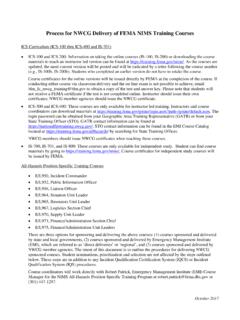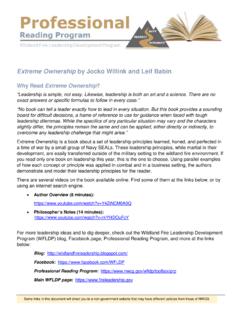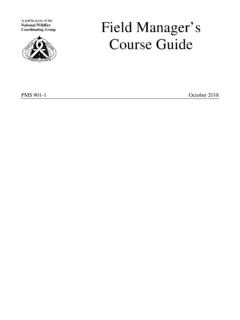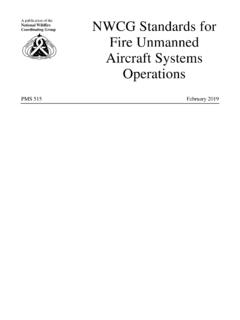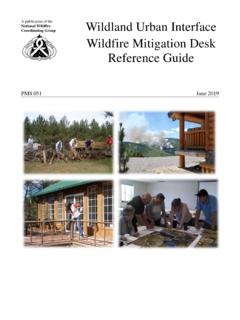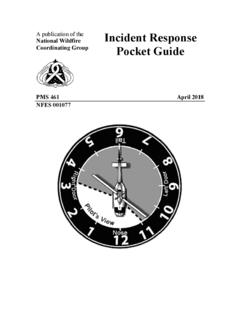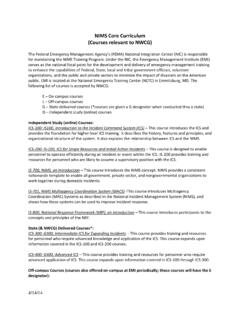Transcription of NIMS Courses Accepted by NWCG
1 January 2015 nims Courses Accepted by nwcg The Federal Emergency Management Agency s (FEMA) National Integration Center (NIC) is responsible for maintaining the nims training Program. Under the NIC, the Emergency Management Institute (EMI) serves as the national focal point for the development and delivery of emergency management training to enhance the capabilities of Federal, State, local and tribal government officials, volunteer organizations, and the public and private sectors to minimize the impact of disasters on the American public. EMI is located at the National Emergency training Center (NETC) in Emmitsburg, MD. The following list of Courses is Accepted by nwcg : E On-campus Courses L Off-campus Courses G State delivered Courses (* Courses are given a G designator when conducted thru a state) IS Independent study (online) Courses Independent Study (online) Courses : ICS-100: IS100, Introduction to the Incident Command System (ICS) This course introduces the ICS and provides the foundation for higher level ICS training .
2 It describes the history, features and principles, and organizational structure of the system. It also explains the relationship between ICS and the nims . ICS-200: IS-200, ICS for Single Resources and Initial Action Incidents This course is designed to enable personnel to operate efficiently during an incident or event within the ICS. IS-200 provides training and resources for personnel who are likely to assume a supervisory position with the ICS. IS-700, nims , an Introduction This course introduces the nims concept. nims provides a consistent nationwide template to enable all government, private sector, and nongovernmental organizations to work together during domestic incidents. IS-701, nims Multiagency Coordination System (MACS) -This course introduces Multiagency Coordination (MAC) Systems as described in the National Incident Management System ( nims ), and shows how these systems can be used to improve incident response.
3 IS-800, National Response Framework (NRF), an Introduction This course introduces participants to the concepts and principles of the NRF. State (& nwcg ) Delivered Courses *: ICS-300: G300, Intermediate ICS for Expanding Incidents: - This course provides training and resources for personnel who require advanced knowledge and application of the ICS. This course expands upon information covered in the ICS-100 and ICS-200 Courses . ICS-400: G400, Advanced ICS This course provides training and resources for personnel who require advanced application of ICS. This course expands upon information covered in ICS-100 through ICS-300. Off-campus Courses ( Courses also offered on-campus at EMI periodically; those Courses will have the E designator): L 950 All-Hazards Incident Commander This course is designed to provide State and local-level emergency responders with a robust understanding of the duties, responsibilities, and capabilities of an effective incident commander on an all-hazards incident management team (AHIMT).
4 These responsibilities fall into two categories: (1) responding to the incident and command needs of the January 2015 incident; and (2) effectively fulfilling the position responsibilities of an incident commander on an AHIMT. Exercises, simulations, discussions, and a final exam enable students to process and apply their new knowledge. L 952 All-Hazards Public Information Officer This course is designed for a public information officer (PIO) assigned to an incident as a member of an AHIMT, local incident management teams (IMT), as well as for the PIO assigned to an incident as an assistant PIO in a variety of capacities. This course will help students develop a strong set of core PIO skills and the ability to apply them within the context of an AHIMT.
5 This course is also distinct from other information function Courses in that it combines elements from both the basic and advanced function to concentrate training on the fundamental duties and responsibilities of PIO in an all-hazard environment. The course material does not assume or require experience as a PIO, but also is not a basic PIO course . Exercises, simulations, discussions, and a final exam enable students to process and apply their new knowledge. L 956 All-Hazards Liaison Officer This course is designed to provide State and local-level emergency responders with a robust understanding of the duties, responsibilities, and capabilities of an effective liaison officer on an AHIMT. Exercises, simulations, discussions, and a final exam enable students to process and apply their new knowledge.
6 L 964 All-Hazards Situation Unit Leader This course helps attendees establish the essential core competencies required to perform the duties of the Situation Unit Leader (SITL) in an all-hazards incident. It addresses all responsibilities appropriate to a SITL operating in a State and local-level AHIMT, including processing information and intelligence and developing displays. The course is instructor-led training that supports learning through discussion, lecture, and active participation in multiple exercises. By requiring attendees to bring a SITL kit to the instruction, the course provides a realistic, hands-on approach to mastering the skills of a SITL. L 965 All-Hazards Resources Unit Leader This course provides an overview of Resources Unit Leader (RESL) responsibilities, the planning section, and the planning process to contextualize the resources unit for students unfamiliar with the planning process or ICS.
7 It then explores specific RESL functions and responsibilities, including resource tracking systems, operational planning, and resource products/outputs. The status/check-in and demobilization functions are covered to provide students with the knowledge to perform those duties if necessary. Exercises, simulations, discussions, and a final exam enable students to process and apply their new knowledge. L 967 All-Hazards Logistics Section Chief This course is designed to provide State and local-level emergency responders with a robust understanding of the duties, responsibilities, and capabilities of an effective logistics section chief on an AHIMT. These responsibilities fall into two categories: (1) responding to the incident; and (2) effectively fulfilling the position responsibilities of a Logistics Section Chief on an AHIMT.
8 Exercises, simulations, discussions, and a final exam enable students to process and apply their new knowledge. L 970 All-Hazards Supply Unit Leader This course helps attendees establish the essential core competencies required for performing the duties of the Supply Unit Leader (SPUL) in an all-hazards incident. By requiring attendees to bring jurisdiction-specific information to the instruction, the course provides a realistic, hands-on approach to mastering the skills of a SPUL organized by the fundamental steps of the ordering process. Attendees identify information required for ordering supplies, complete required forms and documentation related to ordering supplies, and learn to anticipate ordering requirements and supply needs for the incident.
9 In addition to the ordering process, the course discussed mobilization, setting up and managing the supply unit, and demobilization. January 2015 L 973 All-Hazards Finance/Administration Section Chief This course is designed to provide State and local-level emergency responders with a robust understanding of the duties, responsibilities, and capabilities of an effective finance/administration section chief on an AHIMT. These responsibilities fall into two categories: (1) managing the finance/administration section personnel; and (2) managing the finances and administrative responsibilities during an incident. Exercises, simulations, discussions, and a final exam enable students to process and apply their new knowledge. E/L 975 All-Hazards Finance/Administration Unit Leader The finance/administration unit leader course will help students establish the essential core competencies required for performing the duties of the finance/administration unit leader in an all-hazards incident.
10 The course is designed to enable students to perform as any of the four finance/administration unit leaders (time unit leader, procurement unit leader, compensation and claims unit leader, cost unit leader). Students will learn information that is applicable across all four positions, such as unit set-up and management, information gathering, and interactions. Complex experiential exercises and discussions will afford students the opportunity to each act as unit leaders while connecting all information learned back to real-world application.
